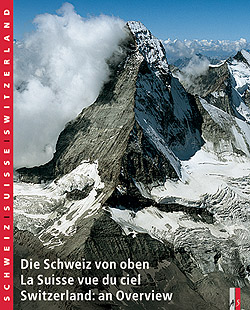|
|
by Robert Allen
 The people of Switzerland, if we believe their pronouncements that the country doesn't exist anymore, are having a genuine crisis about their identity and specifically about their sense of place.
The people of Switzerland, if we believe their pronouncements that the country doesn't exist anymore, are having a genuine crisis about their identity and specifically about their sense of place.
Martin, an ageing chef who works in a family restaurant in Naters, a river village on the northern side of the Rhône in the Valais/Wallis (valley) canton, insists that the unique sense of place Swiss people share with their mountains and valleys is dying out, destroyed by modernity and technology. However another Martin, one of the young project managers who worked at the construction of the 34.6 kilometre railway tunnel through the base of the Alps between Raron in the Valais/Wallis canton and Frutigen in the canton of Berne, took a sense of pride in the creation of this human-built artefact. Functionality is a byword of modern Switzerland. It defines the daily activity of a country that runs to precise timetables and delivers its workers and visitors to their destinations on time, whether by bus, train, funicular railway, cable car, boat or airplane. The workers then deliver a commerce that the people expect, in their offices, schools, factories, farms, shops, restaurants and construction sites. 'Switzerland,’ says Benedikt Loderer, 'is fully utilised.’ The relationship between the human-built world and natural world is the theme of this book, a collection of five essays, which look at these two Switzerlands – Beauty Switzerland and Utility Switzerland. What makes the book breathtaking along with its literary scope are the majestic aerial photographs, which accompany the essays, placing them in a context that cannot refute the perspectives of the essayists. Loderer is the most persuasive with his argument that Switzerland no longer exists. 'The beautiful Switzerland you see is the pre-industrial one,’ he says. 'Within two generations we have consumed too much of Switzerland. [It] is fully utilised. We know precisely what every bit of it can be used for, whether it's a lake, a glacier, a cliff, arable or maintained land. This also means that it's already been decided what the land may not be used for. The main difference is that of construction zones and non-construction zones.’ The Valais/Wallis canton in the south-west of the country is precisely that. The human-built construction zone at the Raron end of the Lötschberg base tunnel contrasts starkly with the natural mountain peaks above, and the creation of an artificial mound containing the tunnel deposits at the southern edge of the Rhône valley flood plain. The relocation – on the orders of the federal government, which commissioned the tunnel – of wildlife disturbed by the construction reveals the sensitive nature of 'nachhaltigkeit' (sustainable development) in Switzerland. This is also Loderer's argument. 'Beauty Switzerland is a recompense for Utility Switzerland,’ he says. 'There are two conditions left in the country; the city and the mountains. We've become tourists in our own country. We commute from Utility to Beauty Switzerland in order to consolidate our identity there. Being convinced of the beauty of the country in our innermost being, we must get out of the agglomeration from time to time and refresh ourselves with a landscape and a picturesque settlement. There are two directions: into the old inner cities or into the mountains. It depends on the type of nourishment we lack. In the old inner city there is more cultural enjoyment; in the mountains, it's more the enjoyment of Nature. And there is a sufficient number of rewarding destinations for both directions. This book proves it.’ Loderer apologises for his cynicism. And he must. This book is an honest appraisal of modern Switzerland and the pictures do prove that Switzerland is still beautiful and rewarding, one of the most attractive countries in Europe. The Switzerland of pristine alpine and lakeside resorts, modern funparks and elaborate transport systems offers as much to the visitor as the Switzerland of precipitous mountain paths, old restaurants and traditional festivals. The photographs – from the 'photoswissair' collection of the Luftbild Schweiz Foundation, started by Walter Mittelholzer, the Swiss pioneer aviator and photographer who began taking aerial pictures in 1918 – show both Switzerlands. They reveal, in glimpses, the Switzerland of the pre-industrial era and the modern Switzerland that contradicts its romantic caricature. Unlike Italy, which is suffocating under the weight of tourist expectation, Switzerland has been allowed to reinvent itself, for good or bad. More than Frenchman Yann Arthus-Bertrand's stunning but selective aerial pictures of human settlements in every region of the Earth, the Luftbild Schweiz photographs reveal an intimacy that only those who live in Switzerland and know every centimetre will fully appreciate. As an overview of a country this book is a perfect portal. From the pictures of the Matterhorn, as if civilisation never existed, to the pictures of the Rhône glacier, where civilisation in the form of a switchback road and a hotel creeps up to the edge of the ice, Switzerland is at once untamed and tamed, a point made by Iso Camartin in his introduction to the book. 'It is not even the boldness with which human beings have made changes in the landscape, opposing the natural-growth and nature-given beauty with another one: that of beautiful design and daring construction.’ Martin, when he was in his tunnel, would agree that daring construction now defines Switzerland. Martin, in his kitchen, would not. For him Switzerland is and always will be the mountains. Camartin, however, knows the real truth. 'What are we complaining about?’ he says. 'It's great to live here.’
|
|||
|
|
